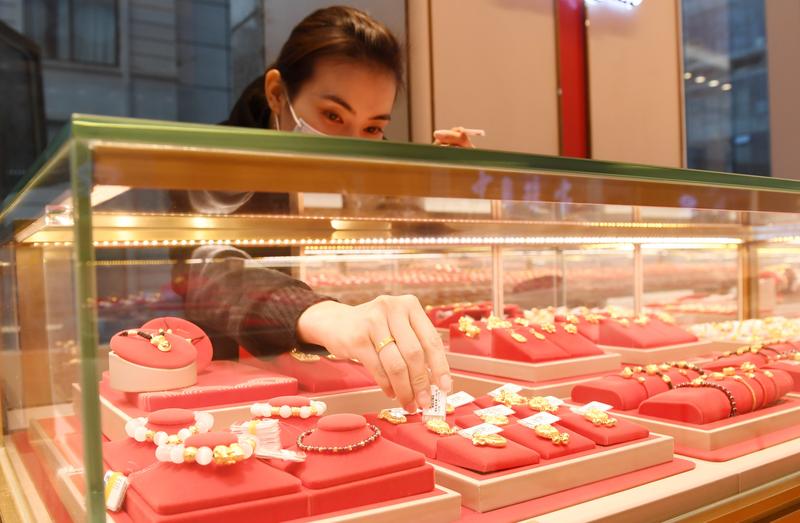 An employee arranges gold ornaments at a jewelry shop in Renhuai, Guizhou province. (CHEN YONG / FOR CHINA DAILY)
An employee arranges gold ornaments at a jewelry shop in Renhuai, Guizhou province. (CHEN YONG / FOR CHINA DAILY)
Central banks' gold reserves around the world have broadly risen over the past 12 months to combat various market headwinds such as inflation or volatility, with the trend set to continue this year, industry experts said.
The People's Bank of China, the country's central bank, added 970,000 ounces of gold holdings in December, according to the bank's latest data on Saturday. Its total gold reserves stand at 64.64 million ounces after the latest purchases.
It is the second consecutive month for the PBOC to increase its holdings of the yellow metal, following a 103,000-ounce purchase in November.
It should be noted that China's gold reserves had remained unchanged for three years since September 2019.
Thanks to the PBOC's higher demand for the precious metal, A-share firms with business related to gold mining or retailing performed strongly. They reported an average share price increase of 0.21 percent on Tuesday, while the benchmark Shanghai Composite Index shed 0.21 percent.
Similar practices have been seen elsewhere. According to the World Gold Council, net gold purchases made by central banks worldwide spiked 47 percent year-on-year to 50 metric tons in November. Turkiye, Uzbekistan and India made the largest increases in gold holdings in November, which was in line with the overall trend throughout 2022.
Central banks around the world shored up gold reserves in 2022 at a pace not seen since 1967, when the US dollar was still backed by the precious metal, according to the WGC.The pace has been further accelerated since November. To date, central banks' total gold reserves have reached 36,745 tons, the highest level since November 1974, added the WGC.
Gold's stable and uncorrelated performance amid global market turbulence, including soaring inflation and more volatile equity markets, partly contributed to the "exceptional" net buying from central banks last year, said WGC experts.
While the greenback jumped 8 percent and the yield of US Treasury Inflation-Protected securities rose an unprecedented 250 basis points last year, gold still managed to eke out a 0.4 percent gain on a yearly basis. This, according to WGC experts, was extraordinary, for when TIPs yields reported the previous largest annual increase of 150 bps in 2013 — a time when the US dollar remained flat — gold prices plunged almost 30 percent.
Past experience showed that gold price rallies came after central banks increased their gold reserves, said the WGC. When central bank bulk gold purchases were reported in 2011 and 2018, gold prices rose 28 percent and 1 percent, respectively.
Analysts from CITIC Securities believe the yellow metal is likely to maintain its upward momentum and may break the previous record of $2,075.14 per ounce seen in August 2020.
Ronan Manly, a precious metals analyst with Singaporean dealer BullionStar, said that central banks' sizable appetite for gold can be interpreted as part of de-dollarization strategies. The accumulated gold reserves in Europe and emerging economies can be read as their ways to avoid or bypass international transactions dominated by the greenback.
Anticipating a lackluster stock market in the US this year, Swissquote Bank analyst Ipek Ozkardeskaya said overall appetite for gold will further increase to hedge against fresh market turbulence.
With the upcoming Chinese Lunar New Year, which starts on Jan 22 this year, gold consumption at the retail end will pick up in China based on past experience, said experts from Minsheng Securities. The recovery in consumer confidence will also boost discretionary buying, including gold.


